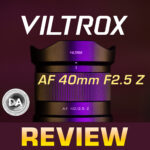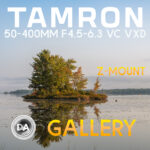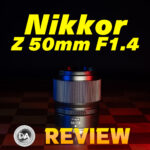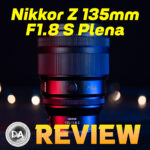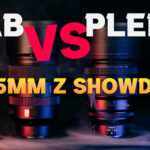
Tamron 35-150mm F2-2.8 VXD Z-Mount Review
I periodically get asked a question that goes something like this, “If you could only own one lens, which lens would it be?” That’s a terrible question for a gear guy, as my whole business is spending time with a LOT of lenses and cameras. I own current cameras from four different brands (Sony, Canon, Nikon, and Fuji), and own lenses from all of those brands plus Tamron, Sigma, Samyang, Viltrox, Laowa, Voigtländer, Zeiss, 7artisans, TTArtisan, Thypoch, and Yongnuo…plus classic lenses from Takumar, Pentax, Helios, and more. I don’t WANT to own just one lens…but if I had to, it would currently be the Tamron 35-150mm F2-2.8 Di III VXD. Since I added that lens to my kit (on Sony E-mount) in October of 2022, it has been my most used lens because it is easily the best option for when I need to capture events or need versatility. I’ve even used it some for travel despite it being larger than optimal for that purpose because it is just so good. It combines great image quality with a hugely useful focal range and a fast maximum aperture throughout. But since adding Nikon to my personal kit in 2024 (I bought a Nikon Z8 in May of 2024), and since Z-mount has been slowly opening to Tamron products, I was very interested in seeing how my favorite lens works on my pretty impressive Nikon Z8 body. You can get my full thoughts in my video review below…or keep reading.
Follow Me @ YouTube | Patreon | Instagram | Facebook | DA Merchandise | Flickr | 500px | X
__________________________________________________________________________________________________
Thanks to Tamron USA for sending me a review copy of this lens. As always, this is a completely independent review. All opinions and conclusions are my own. *The tests and most of the photos that I share as a part of my review cycle have been done with the 45MP Nikon Z8, which I reviewed here.
__________________________________________________________________________________________________
At this stage the optical prowess of this lens is well documented, and I’ve actually put it to harder optical tests on Sony due to having higher resolution bodies available there. The 45MP of my Nikon Z8 is high resolution, to be sure, but not nearly as high of resolution as the 61MP of my Sony a7RV. I was more interested in seeing how well the lens functioned on Nikon. How well did it autofocus? Were there any unexpected quirks that showed up in the transition? Are there any actual improvements?

As I look back over my images, I’ve used the 35-150Z (as I’ll call it for brevity in this review) for church events, graduations, portraits, general purpose photos, and more. I’ve used it in very dimly sit gyms, conferences centers, churches, for fireworks, and on sports fields. In all of these venues the lens has performed exceptionally well, delivering well focused results (even when shooting in very dim conditions) and exceptional image quality.

The 35-150Z is not an inexpensive lens. As has been the trend with the Z-mount versions of Tamron lenses, it is a bit more expensive on Nikon than it was on Sony. The Z-mount version has an MSRP of $2000 USD, while the E-mount debuted at $1900 USD. I suspect that the extra money is probably a license fee to Nikon (for access to Z mount) that is being passed on to consumers, though I don’t have independent verification of that. It’s also not a small lens, and the larger mount diameter of Z-mount adds about 15 additional grams to the weight (1188g on my scale).
But the Tamron 35-150Z is worth it. It is so versatile and essentially is good at everything.

This review will be a mixture of new content along with some existing content, as the build, design, and basic specifications are the same as the Sony E-mount version. I will thoroughly update the review with appropriate autofocus, optical, and handling updates for Z-mount.
Build and Handling
The 35-150Z is, as noted, not a small lens. How could it not be when it has both a larger zoom ratio (4.3x) than either a 24-70mm (2.9x) or a 70-200mm (2.86x) while also having a larger maximum aperture over some of that zoom range? The truth of the matter is that this is actually a fairly moderately sized lens with that in mind, though in some ways the perception challenge that Tamron is going to face is actually due to their successful downsizing of the 70-200(ish) formula with their very successful 70-180mm F2.8 VXD (which is actually sold under the Nikkor brand on Z-mount). That lens was only 151mm long (about 50mm less than the typical 70-200mm) and weighed only 795g. The 35-150mm is a larger lens, to be sure, but not dramatically so. It is a little bit longer (158 vs 149mm) and more noticeably heavier (1188g vs 810g). The 35-150Z is 89.2mm (3.5″) in diameter and 158mm (6.2″) in length. It weighs (according to Tamron) 1165g (41.1oz), but I don’t think that figure has been update to account for the additional weight due to the larger mount diameter. You can see how much bigger the mount area is compared to the Sony E-mount version (on the left).

Clearly Tamron’s priority here was not compact size and weight but rather quality of performance. As I’ve noted about a few other recent lenses, I suspect that the basic physical realities of the 35-150Z will produce a natural sorting effect on potential buyers. It’s less of travel lens (unless you don’t mind some size and weight, which I documented in this article here) and more of a very versatile event and portrait lens. As a wedding photographer, for example, I’m accustomed to carrying two cameras with more than double that amount of weight between them. What if I could carry just one camera with the 35-150Z on it? I’ve often shot a wedding with a 70-200mm (roughly 1400g) and then a pro-grade 35mm like the Canon 35mm F1.4L II (760g), but because the 35-150mm goes as wide as 35mm, I wouldn’t need that second focal length. That’s where the potential weight savings might be.
So yes, this is a large lens, but not larger than the multiple lenses that it could replace.

Tamron’s previous design philosophy had been pretty spartan, but the 35-150Z is a more expensive lens and has been given a little more premium treatment in terms of features. We have function buttons in a total of three positions to allow easy access whether in landscape or portrait orientation. This button can be programmed to different functions from within your camera body…or by using Tamron’s Lens Utility Software (more on that in a moment).

There’s also a bank with a couple of switches. These include the standard AF/MF switch (always welcome) along with a secondary switch that allows access to multiple custom modes. These custom modes can be programmed via the weathersealed USB-C port on the side of the lens.

Simply attach the lens to your computer (or Android device) via USB-C and download Tamron’s free Lens Utility software, and this opens up a variety of ways to customize the performance of your lens. Some of the potential functions include a preset A-B focus pulls, presetting a specific focus distance (like for an event), switching between focus and aperture for the focus ring, changing the speed and/or tension of the manual focus ring, and more. You can also do direct firmware updates via the USB port.

Essentially this is the functionality of the Tamron Tap-In Console now accessed through a weather sealed USB-C port, meaning that you don’t have to buy something in addition. Here’s a quick look at the functionality of the Lens Utility software, or you can visit this page to download the software and/or get more information:



We’ve also got a zoom lock switch to prevent zoom creep, though I didn’t actually encounter any real creep while out hiking with the lens. This is a very well made lens.

Also present on the barrel is two rings. The closer (and slightly narrower, though both are wide) of the two is the zoom ring. I’ll make a minor complaint here, as this ring’s position is opposite of some of Tamron’s other zoom lenses. I have found that sometimes when working with two of Tamron’s lenses at the same time, I found myself continually reaching for the wrong ring because they were reversed. I recognize that this was almost certainly an engineering necessity, but it is an annoyance nonetheless. On a positive note, the zoom ring’s friction is very well damped. It has a smooth, substantial zoom action (not light, however) and there is a moderate inner barrel extension of about 45mm. The tolerances are tight, and there is not wobble or play in the barrel.


The second ring is the manual focus ring and it is near the front of the lens, and, surprisingly, it is even wider than the zoom ring. This is part of why I reached for it, as not only it’s position but its size is not conventional. Focus (like all mirrorless lenses) is focus-by-wire, meaning that focus input on the focus ring is routed through the focus motor to move the elements. Manual focus emulation is quite good, and the good, thick focus ring gives the impression of being a real manual focus experience. The addition of the USB-C port means that that you also have more control over the behavior of the focus ring. This includes being able to control the rotation of the ring and to choose whether the focus action is linear or non-linear (speed sensitive) in behavior. That just adds to the value of the ring.

Tamron has included a nicely made, fairly shallow lens hood that (in a rare move for Tamron) has a locking mechanism. It bayonets into place very cleanly and helps provide some shading along with some bump protection. You’ll also notice up front that Tamron has (necessarily) abandoned their 67mm front filter thread standard for this lens. We’ve got a larger but still standard 82mm front filter thread. It would have been physically impossible to design this lens with with such a small front element.

Tamron started upping their game with their physical designs about the time of the release of the E-mount version of the 35-150mm. The finish is a little glossier and (according to Tamron) the finish has been upgraded to be more resistant to scratching and even fingerprints. The new finish makes the lens appear to be more like anodized metal, though I do think there’s still some engineered plastics in the construction. There’s a platinum-colored accept ring right near the lens mount. There is also some new sculpting to the lens design the gives it more shape. This does have some ergonomic value, as it makes the lens fit the hand a little better. It is worth noting that the lens does feel very good in the hands. Heavy, yes, but in a reassuringly substantial kind of way. Some will find the lens too heavy, but others will love the way it feels while using it. Anecdotally, I went to visit my son at university and walked all over the campus and the nearby waterfront with only the very thin Peak Design Leash strap I keep in my small camera bags. Despite the heft of the lens I walked with the lens for hours and never felt uncomfortable, though, to be fair, I am accustomed to heavier gear. I’ll also note that I’ve been using my E-mount version of the lens extensively for about three years, and it still looks as new as the Z-mount version I’m reviewing now.

Tamron has really been nailing weather sealing, and that’s definitely the case here. There’s a rubber gasket at the lens mount that suggests at the weather sealing inside, and Tamron also shows a total of 10 other internal seal points along with a fluorine coating on the front element to give further protection. A fluorine coating not only helps protect the front element from scratches but also makes it water and fingerprint resistant and thus easier to clean. This is a professional grade lens ready for professional use.

Tamron’s recent trends regarding MFD (minimum focus distance) hold true here, as the lens sports two different MFDs for wide (0.33m/13″) and telephoto (0.85m/33.5″). You can get to about 0.18x magnification on the wide end (1:5.7) and 0.17x (1:5.9) on the telephoto end. Neither figure is exceptionally high, though useful enough to get some closer shots. Here’s what maximum magnification looks like first at 35mm and then 150mm along with a real- world close shot at 35mm.



Both results are fairly good, with a little more contrast on the wide end but you can unlock creamier backgrounds on the long end and get a flatter plane of focus. Minimum focus distance will scale between these two extremes as you go throughout the zoom range. I lean towards the 150mm end due to the better working distance and more strongly blurred backgrounds.

Tamron has nine rounded blades in the aperture iris, and they claim that the aperture iris will stay circular for at least two stops down from maximum aperture. That seems accurate to me. Here’s a look at F2-F4:



There is some deformation near the edge of the frame, with one stop down (F2.8, here) being the best looking in terms of circular shapes while also being nice and big. F4 looks good as well, though by F5.6 you’ll start to see the edges of the blades a bit. This has an important function, though, as it allows for sunbursts at smaller aperture. The nine blades make for a slightly busy but fairly good looking sunburst effect, as you can see here.

Tamron elected to forego including their VC (Vibration Compensation – Tamron’s optical stabilization system) on the 35-150Z. In my case that didn’t prove an issue due to the excellent IBIS (in camera VR) of my Nikon Z8 body, though nor mileage may vary based on your camera.
One area of internet consternation (whether real or imagined) is that the A058 has no tripod collar. Some people have concerns over the stress on the lens mount, though I think this is overwrought. This lens is far from being outside the realm of normal lens weight, and cameras are designed around a strongly reinforced lens mount. My only frustration with it was during the time I was trying to line up my test chart, and, the further you zoom out, the more the weight is towards the front of the camera and it puts a little more stress on the tripod head. So yes, a tripod collar would have provided better balance on a tripod, but again, it would have also added weight and expense. I haven’t really missed having a tripod collar much in three years of ownership of the E-mount version.

There’s no getting around that this is a fairly large and heavy lens, but it is clearly a well made lens that has very high functionality. It is a nice match to my larger Z8 body, though those shooting with a smaller camera may have more of a balance issue.
Autofocus and Video
Tamron has given the 35-150Z their premium focus system, the Voice-coil eXtreme-torque Drive (VXD), which is a high end linear focus motor.

This is a big lens with big elements, so it needs a powerful focus motor to move them quickly. That’s what we have here, and, for the typical things this lens will be used for, the focus system is impressively good. I’ve found it has kept up with everything that I’ve used the lens for over the past 5-6 weeks (and for years on the Sony version).
Focus sound is very quiet, with just some very faint whirring if you put your ear near to the barrel. Focus speed is just one notch below the very fastest lenses, and it is “fast” rather than “instant”. The best focusing lenses have multiple motors to drive focus; from what I can tell the 35-150Z has just one…but a very good one. In most situations focus speed is near instant in practice.

One of the most challenging situations I threw at the lens was a middle school graduation. Their theme was “Under the Sea”, which meant that the gym lighting was extremely low. I had to shoot the whole thing at very high ISO settings (minimum 12,800), which means that the focus system of the camera/lens combo was being challenged. While it was difficult to maintain the kind of shutter speed that I would prefer in that setting when people were moving around, I was very satisfied with the quality of focus on my various shots.



We shared my photos far and wide with parents of graduates because few of their photos turned out in those lighting conditions. When things slowed down after the ceremony, I was able to get some surprisingly good photos even though I was shooting at ISO 12,800 (and only a shutter speed of 1/60th of a second here, which shows you how dim the lighting was.

The combination of a great focus system in the Z8 and an effective focus motor in the 35-150Z made this challenging situation relatively easy. I shot a high school graduation as well, and while the lighting was slightly better there, I lived at ISO 12,800 there as well. I shot hundreds of well focused photos throughout the evening.

All of this means that shooting in better lit situations was a piece of cake. Even the typical event lighting (1600-3200) produced essentially instant focus results.

This really is an amazing event or wedding lens, and the focus system delivers nearly instant results in a variety of lighting conditions.
It is also a fantastic portrait lens, with eye detect working consistently well.



Tamron lenses on Nikon are more compelling for sports than on Sony due to Nikon not having an artificial limit on burst speed. I can shoot at the full 30 FPS on my Z8, and autofocus seems capable of keeping up. Here’s a shot from a sequence of fireworks on Canada Day this year.

Video AF is likewise excellent. When I tested focus pulls, they were snappy and confident. No settling or pulsing. There is some focus breathing, but not a significant amount.
My “hand test” where I alternately block the camera’s view with my hand and then remove the obstruction of my hand went fairly well. Focus moved back and forth fairly well (though it sometimes lingered a bit on either my hand or face), but when locking onto my face the focus was precise and stable.
Overall the Tamron 35-150mm F2-2.8 VXD is a very good focusing lens on Nikon. I would say that focus quality is pretty much first party level.
Image Quality Breakdown
The Tamron 35-150mm F2-2.8 VXD comes with high expectations for performance. It’s a premium lens with a premium price, so expectations are high for this lens to deliver stellar results. I would say those expectations are largely realized, as I got a lot of really fantastic images with the lens that delighted me on both an aesthetic and technical level. Here’s one of my favorites from the Sony E-mount version:

To be fair, that scene was pretty fantastic, so it was likely to make any lens look good. We’ll dive a little more deeply into the technical side of things, though. This is quite a complex optical formula, with 21 elements in 15 groups. This includes three molded glass aspherical elements along with four LD (Low Dispersion) elements. A look at the MTF charts show that the center of the frame is impeccable throughout the zoom range; resolution even of the more demanding 30 lp/mm is between 93-98% resolution even wide open (that’s very high!). Corners are softer, with the weakest performance being at 35mm, F2, where the corners dip to as low as 55% in the extreme corner. Contrast looks strong according the MTFs, too, and that was certainly the case in the real world.




The Nikon Z-mount version is the same lens optically, so the truth of the matter is that I’ve already given it a sterner test on Sony due to the higher resolutions available there. What I do find that varies from mount to mount is the amount of vignette present. Different mounts have different diameters, so in this case the larger diameter of the Z-mount often translates into more vignette.
We’ll dive into the technical side of things first with a look at vignette and distortion at 35mm, F2:

Nothing objectionable there at all. A very mild amount of pincushion distortion (-2) and, as expected, more vignette than on Sony (+62 to correct on Nikon, a +42 to correct on Sony). That’s between 2 and 3 stops in the corners. Profile corrections in camera (JPEG or video) or in software (RAW files) will correct things painlessly.
At 150mm the distortion increases (-9 to correct) as does vignette, and the gap between Z-mount and E-mount is more significant.

Vignette only required a +44 to correct on Sony, while I had to dial in a +80 for the result above on Z-mount.
I didn’t see any issue with color fringing in my tests. It seems to be very well controlled.

I looked for lateral chromatic aberrations on both my charts and real world images, and just didn’t see them. The edges have clean transitions from dark to light.

All very good so far, and this points towards a promising optical performance in terms of sharpness and contrast. Here’s my test chart.

Crops and comparisons are shown at roughly 200% and are from the 45MP sensor of my Z8. Here’s a look at 35mm, F2, with crops from the center, mid-frame, and bottom right corner:



Center performance is (as advertised) excellent, and gets even sharper when stopped down to F2.8. F2.8 results are essentially perfect, as is the mid-frame. As the MTF suggests, acuity is lower in the corners (though they are still decent). They look excellent at F5.6, though, so choose smaller apertures if sharpness across the frame (like for landscapes) is a priority. Real world landscapes look gorgeous.

I haven’t hesitated to use the lens at F2 and F2.8 for people shots at 35mm. There’s plenty of detail there.

This is a variable aperture zoom, as noted, and while it does start at an exceptional F2, that doesn’t last long. By 50mm maximum aperture is F2.2. Center results look good at F2.2, while a mild stop down to F2.8 makes for exceptional results. This is true in the mid-frame as well, and corners are a little sharper (and sharpen up to excellent faster).

By 70mm the maximum aperture is F2.5, still faster than the average zoom, but by only one third stop. The center performance looked a little weaker to me wide open, but the opposite was true out towards the edges of the frame, where things look great. Details for portrait work looks great, however, with great contrast and detail even at 100%.


By 85mm the maximum aperture is the smallest of the zoom range at F2.8, though this is still the standard aperture for pro-grade zoom lenses. Image quality across the frame at F2.8 is exceptional, though.
In my Sony E-mount review I tested more focal lengths, but since I’ve already tested the lens at a higher resolution point than I can on Nikon, I’m going to move on to 150mm here. You can look back to the Sony review if you want more information at other focal lengths.
150mm continues to look very strong, without the big drop-off that often afflicts zooms with a big zoom range. The center is extremely sharp, the mid-frame is good, and the corners, while softer compared to other spots, are still very crisp.



150mm was easily my most used focal length during my review period, and I was consistently happy with real world sharpness in a variety of situations.



As a variable aperture zoom it is not only the maximum aperture that varies (F2 – F2.8), but also the minimum aperture, which varies from F16 – F22. After F11 you will see some softening of the image due to the effects of diffraction. How much will vary depending on the resolution level of your camera.

I’ll also note here that centering was good on my tested copy, with equal results in all four corners. I’ve seen good manufacturing tolerances on Tamron lenses throughout their mirrorless design phase.
I’ll also add that real world images had a lot of “pop” to them. That pro-grade contrast, color, and subject isolation makes images look great.

In my initial Sony review, I noted that the one optical vulnerability was flare resistance. In the years since that review, and having used the lens for thousands of shots, I haven’t actually found it to a major issue. I do see some flare artifacts periodically, but rarely the “image breaking” variety. And during my review of the Nikon Z-mount version, it’s been even less of an issue. I’m not sure if the coatings have been improved a bit over time, or if I just haven’t encountered the same kinds of lighting conditions that caused me problems in my initial review. You can see in this shot, for example, that there are some minor flare artifacts, but nothing too serious.

You are most likely to encounter issues on the telephoto end with strongly backlit subjects, but it is often easier to avoid the backlighting with a narrower angle of view.
I generally found bokeh to be very pleasing from the lens. A lot of images showed really soft, artful bokeh rendering. Specular highlights on the wide end are surprisingly round across the frame even at F2.

Longer focal lengths will allow you to strongly blur the background at F2.8.

This will allow you to get the nice, shallow depth of field for portraits that we all like.

A few situations with busier backgrounds looked a little less pleasing to my eye, but neither is the bokeh objectionable here, either.

I was able to test coma, as the maximum aperture of F2 on the wide end opens up another application for the lens. The results were generally positive, with nice, crisp detail to the night sky, though a pixel level look does show a bit of coma in the edges of the frame.



All told, there is a whole lot of good going on here, and one of the huge attractions of the Tamron 35-150Z is that is allows you such amazing flexibility in the zoom range but without compromising image quality. Check out the image gallery link here for more photos.
Conclusion
In general, I remain a huge fan of the Tamron 35-150mm F2-2.8 Di III VXD lens on Nikon as well as Sony. The 35-150Z is big, heavy, and expensive, but it also does just about everything very competently, and you could easily justify it as your solo lens. It can replace multiple lenses easily, and very likely best them in optical performance at the same time.

A lot of the images in this review are “practical” images, as I find the 35-150Z my “go-to” lens when I want to take a single lens along. I find it the best event lens that I’ve ever used, and I’m consistently happy with both the versality of the lens during image capture and the images that I’m able to capture with it.

This is a huge addition to the Nikon Z-mount platform, as there is no other lens quite like this for the system. I genuinely think this is a “system selling” kind of lens, and it’s addition on Z-mount is big enough that it might sway me if I were debating between, say, Canon RF and Nikon Z. The Tamron 35-150mm F-2.8 Di III VXD lens is just that good. Now you just have to come up with $2000 to buy one!

Pros:
- Innovative and useful focal range
- Larger maximum aperture than competitors at points
- Advanced weather sealing with 11 seal points
- Fluorine coating
- Functional and attractive shape
- Excellent feature set
- Good build and action of rings
- Long term durability (*based on Sony E-mount version
- Powerful VXD focus motor
- Quick and quiet autofocus
- No burst rate limitations on Z-mount
- Strong optical performance throughout zoom range
- Exceptional contrast and “pop” to images
- Excellent control of chromatic aberrations
- Nice looking bokeh
Cons:
- Lens quite large and heavy
- $100 more expensive on Z-mount
- Ring position reversed from other Tamron zooms
- No tripod collar
- No lens stabilization
- Some flare issues
_________________________________________________________________________
GEAR USED:
Purchase the Tamron 35-150mm VX @ B&H Photo https://bhpho.to/3LDFC4Z | Adorama https://howl.me/cmJ9G02cCeJ | Amazon https://amzn.to/3zW2wC1 | Camera Canada https://shrsl.com/4mdaw | Amazon Canada https://amzn.to/3WBfNsu | Amazon UK https://amzn.to/3Wis83E | Amazon Germany https://amzn.to/4dkzv1r
_______________________________________________________________
Purchase the Nikon Z8 @ B&H Photo | Adorama | Amazon | Camera Canada | Amazon Canada | Amazon UK | Amazon Germany
_________________________________________________________________
Want to support this channel? Use these affiliate links to shop at: B&H Photo | Amazon | Adorama | Camera Canada | Amazon Canada | Amazon UK | Ebay | Make a donation via Paypal
Buy DA Merchandise https://bit.ly/TWIMerch

Keywords: Tamron 35-150, Tamron 35-150mm, Tamron 35-150mm F2-2.8, Tamron 35-150mm Review, Review, VXD, #withmytamron, A058, F2-2.8, Nikon, Nikon Z8, Z, Z-mount, Z8, Review, mirrorless, Full Frame, Sports, Tracking, Dustin Abbott, Real World, Comparison, Handling, Focus, Portraits, Resolution, High ISO, Image Quality, Sample Images, Photography, 45MP, #letthelightin, #DA, #NIKON, #Z8, #NIKONZ8



